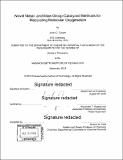| dc.contributor.advisor | Alexander T. Radosevich. | en_US |
| dc.contributor.author | Cooper, Julian C.(Julian Colton) | en_US |
| dc.contributor.other | Massachusetts Institute of Technology. Department of Chemistry. | en_US |
| dc.date.accessioned | 2020-03-09T18:50:55Z | |
| dc.date.available | 2020-03-09T18:50:55Z | |
| dc.date.copyright | 2019 | en_US |
| dc.date.issued | 2019 | en_US |
| dc.identifier.uri | https://hdl.handle.net/1721.1/124046 | |
| dc.description | Thesis: Ph. D., Massachusetts Institute of Technology, Department of Chemistry, 2019 | en_US |
| dc.description | Cataloged from PDF version of thesis. | en_US |
| dc.description | Includes bibliographical references. | en_US |
| dc.description.abstract | Synthetic methodologies frequently rely on oxygen functionality as a synthetic handle to enable structural modification of organic molecules; therefore, methods that enable new ways to modulate oxygen content in molecular structure facilitate structural diversification. This thesis details the development of catalytic methods affecting oxygen incorporation in organic molecules. These methods make use of fundamentally distinct strategies in bond activation to oxygenate and deoxygenate molecular architectures. First, a metal induced bond-weakening, dual-catalytic strategy was implemented to oxidize the benzylic positions of azaheterocycles. Coordination of a metal catalyst to the nitrogen lone pair is thought to induce weakening of proximal C-H bonds such that a radical catalyst with tunable chemoselectivity breaks this weakened bond. In the presence of an oxygen atmosphere, this leads to carbon-oxygen bond formation. | en_US |
| dc.description.abstract | This two-catalyst strategy is applied to the oxygenation of the benzylic positions of pharmaceutically relevant heterocycles, and is found to exhibit site selectivity for the electron poor azaheterocyclic positions, thereby addressing a longstanding challenge in catalytic C-H oxidation methods, which are typically selective for more electron-rich positions. Complementing metal catalyzed oxygenation, a main group-catalyzed method for deoxygenation is detailed. Geometrically distorted phosphorus compounds are shown to be competent catalysts for reductive 0-atom transfer, enabling the deoxygenation of nitroarenes and carbonyls, thereby realizing new reactivity for these functional groups. This main group catalysis renders nitro groups competent coupling partners for C-N bond formation, enabling cross coupling with an aryl boronic acid or anti-Markovnikov hydroamination with olefins. While catalytic 0-atom transfer with organophosphorus is well-studied, asymmetric variants remain limited. | en_US |
| dc.description.abstract | Advances in asymmetric carbonyl functionalization with distorted redoxactive phosphorus catalyst are presented, with the ultimate goal of gaining a greater understanding of the many factors that affect stereochemistry during these reactions. | en_US |
| dc.description.statementofresponsibility | by Julian C. Cooper. | en_US |
| dc.format.extent | 292 pages | en_US |
| dc.language.iso | eng | en_US |
| dc.publisher | Massachusetts Institute of Technology | en_US |
| dc.rights | MIT theses are protected by copyright. They may be viewed, downloaded, or printed from this source but further reproduction or distribution in any format is prohibited without written permission. | en_US |
| dc.rights.uri | http://dspace.mit.edu/handle/1721.1/7582 | en_US |
| dc.subject | Chemistry. | en_US |
| dc.title | Novel metal- and main group-catalyzed methods for modulating molecular oxygenation | en_US |
| dc.type | Thesis | en_US |
| dc.description.degree | Ph. D. | en_US |
| dc.contributor.department | Massachusetts Institute of Technology. Department of Chemistry | en_US |
| dc.identifier.oclc | 1142098540 | en_US |
| dc.description.collection | Ph.D. Massachusetts Institute of Technology, Department of Chemistry | en_US |
| dspace.imported | 2020-03-09T18:50:53Z | en_US |
| mit.thesis.degree | Doctoral | en_US |
| mit.thesis.department | Chem | en_US |
